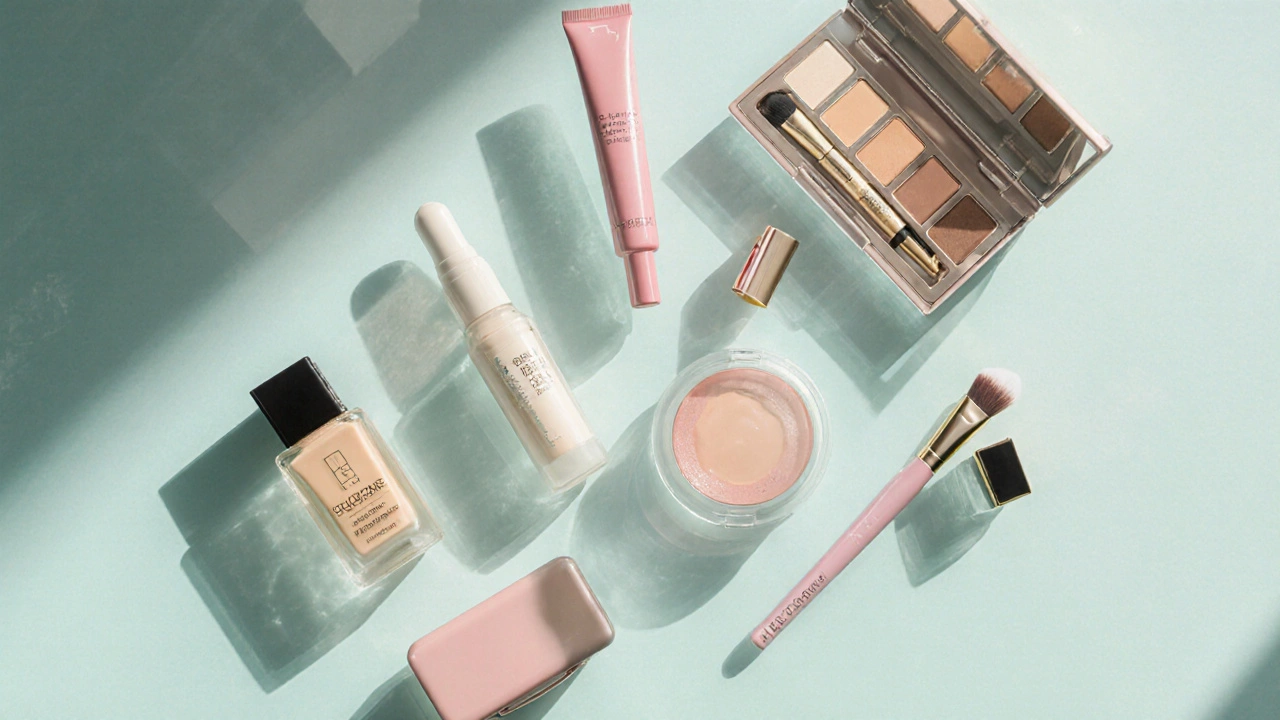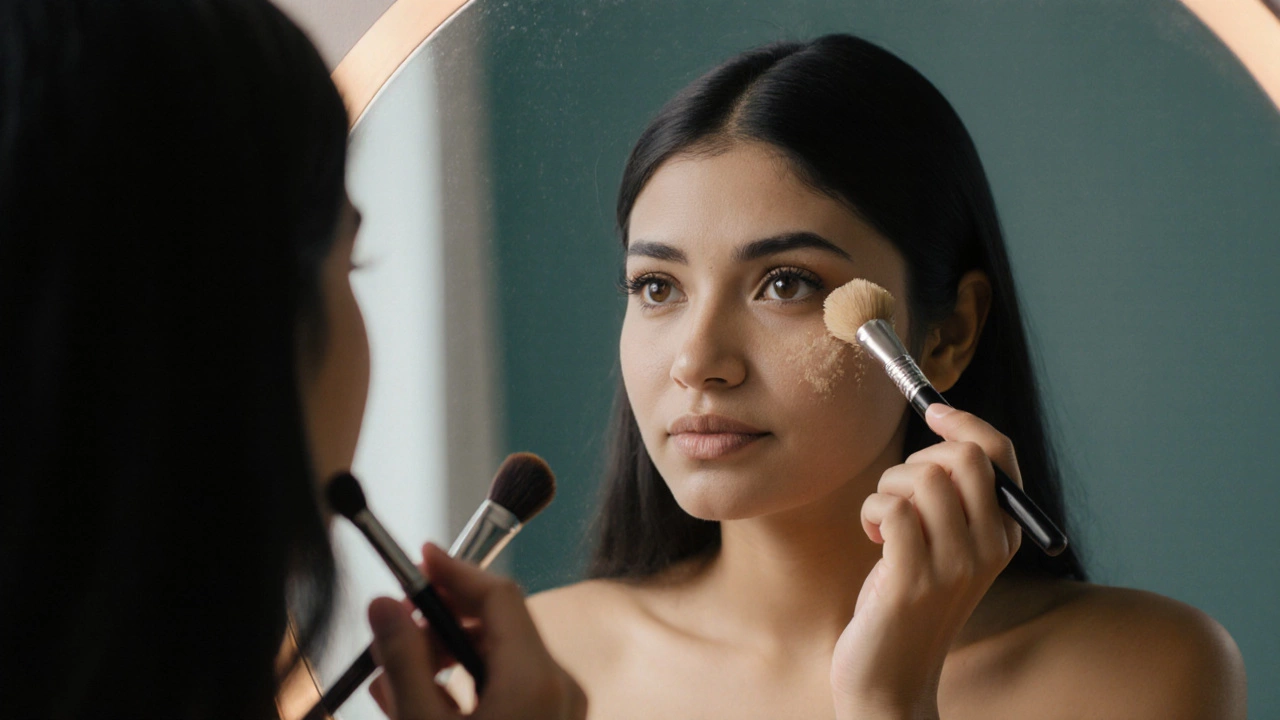
Beginner Makeup Kit Builder
Select the products you'd like to include in your beginner makeup kit. The total price will update automatically.
Foundation
Even out skin tone and create a uniform base
Concealer
Target dark circles and blemishes
Mascara
Define lashes and open eyes
Blush
Add natural glow to cheeks
Eyeshadow Palette
Neutral colors for versatile looks
Eyeliner
Define eyes with easy-to-use pencil
Lipstick
Final statement with creamy formula
Brush Set
Essential tools for application
Key Takeaways
- Start with six core items: foundation, concealer, mascara, blush, eyeshadow palette, and lipstick.
- Choose shades that match your skin tone and suit your lifestyle.
- A small set of quality brushes and a primer can dramatically improve finish.
- Invest in versatile, multi‑use products to keep your kit simple and affordable.
- Understanding each product’s role speeds up your routine and boosts confidence.
When people ask, "What are the basic makeup products you need?" they usually want a short list that won’t overwhelm a beginner. Below you’ll find a clear rundown of the essentials, why each one matters, and tips for picking the right version without breaking the bank.
Basic makeup products are the core cosmetics that let you even out skin tone, add color, and define features. Think of them as the building blocks of any look, from a quick coffee‑run refresh to a full‑glam evening style.
1. Foundation - the canvas
Foundation evens out texture and creates a uniform base for everything else. In 2025 the three most common formulas are liquid, powder, and cream. Liquid foundations offer the smoothest coverage and work well for most skin types; powder versions are great for oily skin and quick touch‑ups; cream foundations give a dewy finish ideal for dry complexions.
| Type | Finish | Best For | Typical Price (USD) |
|---|---|---|---|
| Liquid | Natural‑to‑matte | Combination, normal | 15‑30 |
| Powder | Matte | Oily, acne‑prone | 12‑25 |
| Cream | Dewy | Dry, mature | 20‑35 |
How to pick the right shade? Swipe a small amount along your jawline; the perfect match should disappear into the skin without leaving a line.
2. Concealer - spot‑fix specialist
Concealer targets dark circles, redness, or blemishes that foundation can’t cover. A creamy, medium‑coverage formula works for most issues, while a full‑coverage stick is handy for stubborn spots.
Tip: Choose a concealer one shade lighter than your foundation for under‑eye brightening, and the same shade for spot correction.
3. Mascara - instant eye lift
Mascara defines lashes, opening the eyes and making them appear larger. If you’re new, a waterproof version is a safe bet for all‑day wear, but a non‑waterproof formula is easier to remove.
Application shortcut: Start at the base of the lashes, wiggle the brush upward, then comb through to avoid clumps.

4. Blush - healthy flush
Blush adds a natural glow to the cheeks. Powder blushes are versatile and blend well; cream blushes give a skin‑like finish, perfect for a more “no‑makeup” vibe.
Pro tip: Smile, locate the apples of your cheeks, and sweep the color upward toward your temples for a lifted effect.
5. Eyeshadow palette - color playground
Eyeshadow palette supplies the pigments you need for everyday wear or evening drama. A five‑shade neutral palette is the most budget‑friendly starter-think a light matte, a mid‑tone transition, a deeper matte, a shimmer, and a dark accent.
Quick look: Use the lightest shade as a base, the transition shade on the crease, and the dark accent on the outer corner for depth.
6. Eyeliner - definition on demand
Eyeliner can be a pencil, gel, or liquid. Beginners often prefer a soft‑lead pencil because it’s forgiving; you can smudge for a smoky effect or sharpen for a crisp line.
Fast hack: Place the tip at the center of the lash line, then draw outward to the edge of the eye for a wing‑free cat‑eye.
7. Lip Color - finishing touch
Lipstick or lip gloss acts as the final statement. Choose a neutral nude for everyday wear or a bold red for nights out. A creamy formula with moisturizing ingredients prevents drying.
Application tip: Outline with a lip liner that matches the lipstick shade, then fill in for longer wear.
8. Brush Set - tool of the trade
Makeup brushes are arguably as important as the products themselves. A basic 5‑piece set-foundation brush, concealer brush, blush brush, eyeshadow blending brush, and a small angled brush for liner-covers most tasks.
Keep them clean: Wash with a gentle soap once a week to avoid bacterial buildup that can cause skin breakouts.
Putting It All Together: A Sample Starter Kit
Below is a budget‑friendly checklist that stays under $100 while covering every essential:
- Liquid foundation (shade match) - $20
- Medium‑coverage concealer - $12
- Waterproof mascara - $15
- Powder blush (peach) - $10
- 5‑shade neutral eyeshadow palette - $18
- Soft‑lead eyeliner pencil - $8
- Cream lipstick (nude) - $12
- 5‑piece brush set - $10
This mix gives you enough versatility to create a daytime natural look, a polished office vibe, and a smoky evening transformation.
Tips for Maintaining Your Kit
- Store in a cool, dry place. Heat can change the texture of creams and liquids.
- Rotate products every 12‑18 months; expired formulas may cause irritation.
- Invest in a small travel case to keep everything organized and protected.
- If a product feels too heavy on your skin, try a lighter formula or reduce the amount applied.
Frequently Asked Questions
Do I really need both foundation and concealer?
Foundation creates an even canvas, while concealer targets specific imperfections. Using both gives the most polished finish, but if you’re on a tight budget, a tinted moisturizer with built‑in coverage can replace foundation, and a small concealer stick can handle spot corrections.
Can I use the same eyeshadow palette for both day and night?
Absolutely. Neutral palettes are designed for versatility. Apply lighter shades for daytime and build deeper colors or add a shimmer on the lids for evening drama.
How often should I replace my mascara?
Most experts recommend discarding mascara after three months. The brush can harbor bacteria, and the formula can dry out, leading to clumps and eye irritation.
Is a primer necessary for beginners?
A primer smooths skin texture and helps makeup last longer, especially on oily or textured skin. If you’re on a tight budget, a lightweight primer can be swapped for a mattifying moisturizer.
What’s the best way to clean my brushes?
Rinse brushes under lukewarm water, add a drop of gentle soap, swirl the bristles, rinse until clear, and lay flat to dry. Cleaning once a week keeps the brushes soft and prevents skin breakouts.
 Hair Care
Hair Care